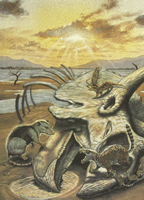The Impact Theory - Dinosaur Extinction
Homepage > Dinosaur
Extinction > The Impact Theory
 In
the early 1980's Luis Alvarez proposed the theory of dinosaur extinction
by an asteroid impact. His theory suggested that an asteroid 9 to 12 miles
(15 to 19 kilometers) in across collided with earth at the end of the
Cretaceous Period, about 65 million years ago.
In
the early 1980's Luis Alvarez proposed the theory of dinosaur extinction
by an asteroid impact. His theory suggested that an asteroid 9 to 12 miles
(15 to 19 kilometers) in across collided with earth at the end of the
Cretaceous Period, about 65 million years ago.
This asteroid impact would create a dust cloud enveloping the globe for months, or even a year. This dust rose high into the atmosphere blocking the sun's rays, causing the earth to be engulfed in darkness.
Photosynthesis in the sea and on land ceased. This caused a domino effect on the pyramid food chain. Plants died or became dormant soon after, herbivores starved and die out, followed by the carnivores.
Some of the best supporting evidence is that high levels of the rare earth element iridium at the K-T boundary and the probable remains of an impact crater. Iridium is an element that is found on earth, especially deep in the earth, high levels of iridium are associated with extraterrestrial events.
 Generally
the greater the impact object, such as an asteroid, the greater in concentration
of this iridium element. The remains of a probable impact structure in
"Chicxulub", a crater approximately 110 miles across at the
north tip of the Yucatan peninsula from at or near the K-T boundary, are
strong evidence for an impact.
Generally
the greater the impact object, such as an asteroid, the greater in concentration
of this iridium element. The remains of a probable impact structure in
"Chicxulub", a crater approximately 110 miles across at the
north tip of the Yucatan peninsula from at or near the K-T boundary, are
strong evidence for an impact.
Neither high concentrations of iridium or a crater impact are direct evidence for specific causes of extinction at the K-T boundary.
The impact generated scenario that extremely high levels of catastrophic extinction across most environments is so large in magnitude that it is difficult to test. Portions of impact theory are more easily tested such as the sudden cold snap, highly acidic rain, or global wildfires using the known K-T vertebrate record.
Impact Winter
 It
is argued that if tremendous amount of dust were ejected into the atmosphere
after a large impact, darkness would not only affect photosynthesis but
also produce extreme subzero temperatures. This is known as "impact
winter".
It
is argued that if tremendous amount of dust were ejected into the atmosphere
after a large impact, darkness would not only affect photosynthesis but
also produce extreme subzero temperatures. This is known as "impact
winter".
Following the asteroid impact, ocean temperatures would decrease only a few degrees because the huge heat capacity of the oceans, but on the continents however, temperatures would last for up to 6 months. These subfreezing temperatures will last for about twice the time of darkness caused by the dust in the atmosphere.
This may explain how some small animals such as mammals and fishes in the oceans avoided extinction. Small animals on land could burrow and find shelter underground from these temperatures, and animals in the oceans were better protected than large animals exposed on land.